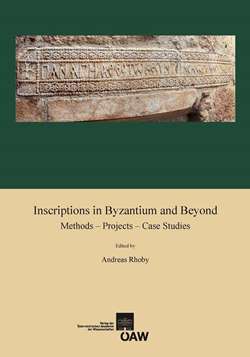Inscriptions in Byzantium and Beyond
Methods – Projects – Case Studies
ISBN 978-3-7001-7674-9
Print Edition
ISBN 978-3-7001-7806-4
Online Edition
Veröffentlichung zur Byzanzforschung 38
Denkschriften der phil.-hist. Klasse 478
2015,
246 Seiten, zahlr. Abb., 29,7×21cm, broschiert
€
65,90

Andreas Rhoby
ist wissenschaftlicher Mitarbeiter am Institut für Mittelalterforschung, Abteilung Byzanzforschung, der ÖAW
Der vorliegende Sammelband – der erste, der zur Gänze Aspekten der
byzantinistischen Epigraphik gewidmet ist – umfasst in erster Linie
Beiträge zweier internationaler Konferenzen (Wien 2010, Sofia 2011). Er
gliedert sich in vier Abschnitte und versammelt unter anderem folgende
Artikel: Nach einem einführenden Beitrag über die „Geschichte“ der
byzantinistischen Epigraphik versucht Cyril Mango den Terminus
„Byzantinische Inschrift“ und seine Grenzen zu definieren. Vincent
Debiais liefert interessante Beobachtungen anhand eines Vergleichs von
westlichen und byzantinischen Inschriften. Der zweite Abschnitt des
Buches trägt den Titel „Methods of Editing Byzantine Inscriptions“:
Während der Beitrag Peter Schreiners die dringende Notwendigkeit einer
neuen epigraphischen Initiative innerhalb der Byzantinistik betont,
beschreibt Walter Koch detailliert die westlichen Inschriftenprojekte.
Sowohl Guglielmo Cavallo als auch Erkki Sironen diskutieren
Editionsrichtlinien, während Charlotte Roueché die Vorteile von
Online-Corpora beschreibt. Joel Kalvesmaki stellt das kürzlich
publizierte epigraphische Font „Athena Ruby“ vor. Der dritte Abschnitt
umfasst Artikel, die über laufende epigraphische Projekte berichten:
Zwei in Griechenland durchgeführte Projekte werden als Datenbank
publiziert werden. Maria Xenaki diskutiert den epigraphischen Reichtum
Kappadokiens und die kaum analysierten Graffiti. Der letzte Abschnitt
ist Fallstudien gewidmet, deren Inhalt von der Spätantike (Sencer Şahin,
Mustafa Sayar) bis in mittel- und spätbyzantinische Zeit reicht (Ida
Toth, Linda Safran).
Gedruckt mit Unterstützung des Fonds zur Förderung der wissenschaftlichen Forschung (FWF).
 …
The present book, the first collective volume entirely devoted to
aspects of Byzantine epigraphy, mainly comprises papers delivered at two
international meetings (Vienna 2010, Sofia 2011). The book is divided
into four sections and includes among others the following
contributions: after an introductory article about the “history” of the
discipline of Byzantine epigraphy Cyril Mango tries to define the term
“Byzantine inscription” and its limits. Vincent Debiais offers some
interesting observations by comparing medieval Latin inscriptions from
the West with Byzantine epigraphic traditions. The second section of the
book bears the title “Methods of Editing Byzantine Inscriptions”: while
the paper of Peter Schreiner discusses the urgent necessity of creating
a new epigraphic initiative within Byzantine Studies, Walter Koch
describes the Western medieval inscription projects in detail. Both
Guglielmo Cavallo and Erkki Sironen discuss editorial guidelines while
Charlotte Roueché stresses the advantages of creating online-corpora,
and Joel Kalvesmaki describes his recently published epigraphic font
“Athena Ruby”. The third section covers articles which report current
epigraphic projects: two projects from Greece presented will be
published within databases. Maria Xenaki discusses the epigraphic wealth
of Cappadocia and its hardly studied graffiti. The last section is
devoted to case studies articles. Their content ranges from Late
Antiquity (Sencer Şahin, Mustafa Sayar) until the middle and the late
Byzantine period (Ida Toth, Linda Safran).
…
The present book, the first collective volume entirely devoted to
aspects of Byzantine epigraphy, mainly comprises papers delivered at two
international meetings (Vienna 2010, Sofia 2011). The book is divided
into four sections and includes among others the following
contributions: after an introductory article about the “history” of the
discipline of Byzantine epigraphy Cyril Mango tries to define the term
“Byzantine inscription” and its limits. Vincent Debiais offers some
interesting observations by comparing medieval Latin inscriptions from
the West with Byzantine epigraphic traditions. The second section of the
book bears the title “Methods of Editing Byzantine Inscriptions”: while
the paper of Peter Schreiner discusses the urgent necessity of creating
a new epigraphic initiative within Byzantine Studies, Walter Koch
describes the Western medieval inscription projects in detail. Both
Guglielmo Cavallo and Erkki Sironen discuss editorial guidelines while
Charlotte Roueché stresses the advantages of creating online-corpora,
and Joel Kalvesmaki describes his recently published epigraphic font
“Athena Ruby”. The third section covers articles which report current
epigraphic projects: two projects from Greece presented will be
published within databases. Maria Xenaki discusses the epigraphic wealth
of Cappadocia and its hardly studied graffiti. The last section is
devoted to case studies articles. Their content ranges from Late
Antiquity (Sencer Şahin, Mustafa Sayar) until the middle and the late
Byzantine period (Ida Toth, Linda Safran).
Selected Bibliography - Index - List of Contributors page 241













 Stumble It!
Stumble It!

No comments:
Post a Comment